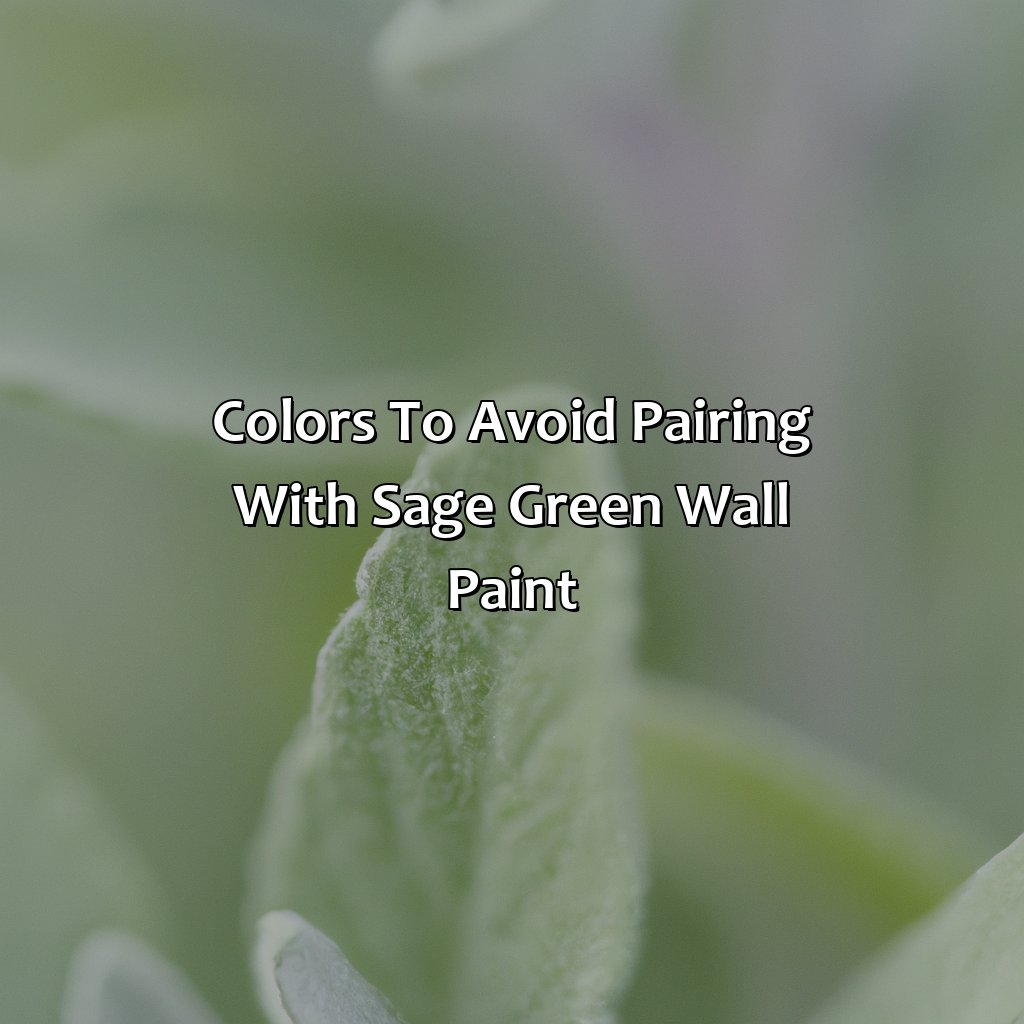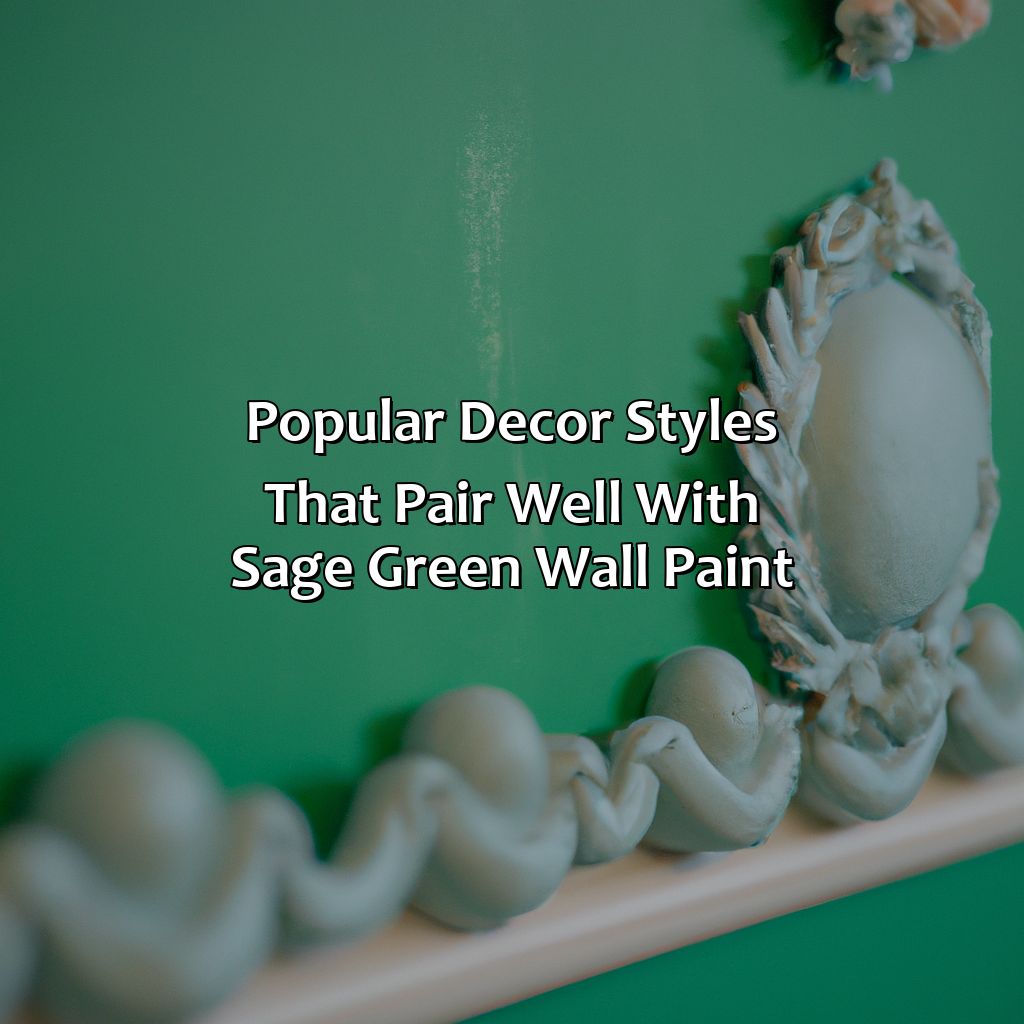##Key Takeaways:
Key Takeaway:
- Soft neutrals, earthy tones, cool blues, and warm yellows complement sage green wall paint. These colors can create a monochromatic or analogous color scheme for a tranquil, relaxing, and soothing atmosphere.
- Avoid pairing sage green wall paint with bright colors, bold colors, stark black, or stark white. These colors can create a color contrast that can disrupt the calming effect of sage green.
- When choosing a color scheme with sage green wall paint, consider the amount of natural light in the space, use color swatches to compare shades, and experiment with different textures and finishes to create a cohesive design.
- Popular decor styles that pair well with sage green wall paint include bohemian, coastal, farmhouse, and mid-century modern. Each style incorporates organic materials, natural fibers, and sustainable products for a cohesive and eco-friendly design.
- Examples of successfully incorporating sage green wall paint into a room design include a bedroom with white bedding and beige accents for a calming oasis, a living room with navy blue furniture and gold accents for a luxurious feel, and a kitchen with natural wood cabinets and brass hardware for a warm and inviting atmosphere.
Colors that complement sage green wall paint

Photo Credits: colorscombo.com by Paul Hall
Find colors that pair great with sage green paint! Check out a color wheel for help. Try earthy tones or muted, natural colors – perfect for a calming vibe. Blues and shades of green? Cool for an analogous or triadic scheme. Warm yellows offer a complementary contrast to the green. Greenery and plant-inspired hues create a tranquil atmosphere. Explore color combinations for this effect.
Soft neutrals
To further enhance this color scheme, consider adding texture and patterns to break up the monotony of solid-colored decor items. By combining different materials such as linen, wool, and cotton with soft neutrals, you create a space that feels welcoming and cozy.
Pro Tip: When choosing soft neutral colors to complement sage green walls, keep in mind the amount of natural light in the room. Natural lighting can impact how colors appear on your walls, so make sure to compare different shades using color swatches before making a final decision.
Nature called and it wants you to decorate with earthy tones to complement your sage green walls.
Earthy tones
Natural colors, such as earthy tones, are an excellent choice for complementing sage green wall paint. These organic hues add warmth and depth to a room while highlighting the calming and serene qualities of the sage green tone. Using neutral shades like beige, brown or grey further enhances this effect. The combination of these earthy and neutral colors creates a cohesive and tranquil atmosphere that promotes relaxation.
Incorporating organic colors in decor choices, such as natural wood furniture or woven textiles can add a touch of rusticity that harmonizes with the sage green wall paint. Moreover, using fabrics with organic fibers provides another layer of texture that accentuates the relaxing ambiance.
Choose accents made with soothing colors like soft blues or warm yellows to balance out the organic warmth of earthy tones. The cool hues counterbalance the warmness by providing visual depth and interest, creating a beautiful contrast against the sage green color palette.
A friend once shared how he incorporated earthy tones with his wife’s favorite sage green wall paint in their living room décor. He opted for beige furniture pieces coupled with wooden flooring and accessories made from natural materials that complemented their space perfectly. By sticking to this color scheme, he was able to create a comfortable yet stylish ambiance that subtly stands out while blending in flawlessly with their interior design vision.
Pairing cool blues with sage green wall paint creates a soothing and harmonious color scheme, like a refreshing green tea with a hint of blueberry.
Cool blues
Colors in the blue family make a great complementary pairing with sage green wall paint. This color scheme presents analogous colors, which are next to each other on the color wheel, or triadic colors, which are evenly spaced apart. The use of cool blues creates a serene and calm ambiance and can be used in different intensities to enhance the room’s character.
To achieve the perfect color scheme with sage green wall paint, try pairing it with lighter shades of cool blues like sky blue or light teal. For those who prefer high contrast designs, dark or royal blue shades can be an excellent choice to add texture and depth to the space.
If you’re looking for something more subtle, consider using pastel shades of blue, such as baby blue or powder blue. Combining these colors not only provides cohesive visuals but can also create enough contrast between light and dark hues.
To get an appealing result while pairing cool blues with sage green wall paint, it is necessary to have a firm grasp on how both hues interact when combined. It is recommended that you experiment with different options using particular textile swatches before applying them to walls to visualize your choices better.
Overall, cool blues with sage green wall paint can create an inviting and relaxing atmosphere that is suitable for bedrooms or living rooms where relaxation is essential. By following color schemes guidelines based on contrasting shapes and complementing colors, paired with suitable positioning of furniture results in an all-around balanced interior that enhances visual appeal.
If sage green is the yin, warm yellows are the yang – they balance each other out perfectly on the color wheel.
Warm yellows
Complementary colors to sage green wall paint include warm yellows, such as buttermilk and creamy tones. These colors evoke a sense of warmth and comfort, creating a cozy atmosphere.
When choosing warm yellows to pair with sage green, it’s important to select shades that complement one another on the color wheel. Thus, shades of green and natural colors like brown or beige can be paired with different gradients of warm yellow.
Experimenting with different textures in fabrics or finishes is a great way to enhance the pairing of warm yellows with sage green wall paint. This combination is perfect for those who want their space to feel inviting yet relaxing.
Pro Tip: Incorporate wood furniture or accents into the room design to create contrast against sage green walls, adding warmth and creating depth in the overall design.
Sorry bold and bright colors, you’re not invited to the sage green paint party.
Colors to avoid pairing with sage green wall paint

Photo Credits: colorscombo.com by Jeffrey Wilson
To complement sage green wall paint, carefully choose colors. Achieve a cohesive look and avoid bright or bold shades. Also, do not pair with stark black and white. Why? Too much contrast. Plus, an overly stark and harsh look. Let’s explore why these colors should be avoided and offer alternatives.
Using bright or bold colors with sage green can create a clashing effect. Generally, pairing sage green with bright colors is not recommended. It can be visually overwhelming and unpleasant to the eye. Instead, opt for muted earthy tones such as tan or beige.
Pairing sage green with stark black and white can have a jarring effect. This color combination can look too sharp and high-contrast, and can detract from the calming effect of the sage green walls. Instead of stark black, try using a softened black, such as charcoal gray. Instead of pure white, try using cream or ivory.
Bright or bold colors
Bright hues or strong pigments do not complement sage green wall paint due to their high color contrast. Using such colors can clash with the softness of the sage green, making the space look jarring and overwhelming. Instead, opting for more muted or earthy tones can create a harmonious balance in the room.
- Contrasting bright colors like neon oranges or hot pinks should be avoided as they gobble up attention and make it difficult to appreciate other elements in the room.
- Bold colors like cobalt blues or fire engine reds may compete with sage green wall paint, creating visual confusion and stress.
- Optical illusions can come into play when strong pigments are used in combination with the wall color causing intense eye strain or headaches.
- If bright or bold colors are used in furnishings, they should be balanced out with neutral accents to avoid overpowering the senses.
To create a cohesive look, it is essential to consider using complementary tones that enhance rather than detract from each other. Harmonizing different shades of colors can help achieve a cohesive balance in any space.
Simplicity is key when it comes to selecting color schemes to go along with sage green wall paint. Muted tones are easier on the eyes and bring about a sense of calmness. Bright hues can take away from this effect if not used wisely.
Research conducted by The Spruce states that bright bold colors tend to stimulate our nerves leading to aggressive behavior thus proving that using them excessively will lead to an unpleasant experience.
Pairing sage green with stark black and white is like putting a turtleneck under a Hawaiian shirt – it just doesn’t work.
Stark black and white
A strong color contrast is not recommended with sage green wall paint. Stark black and white can create an overpowering effect, taking away from the tranquility and warmth that sage green provides. A softer approach to contrasting colors is preferred.
As stark black and white have high contrast, they may catch the eye of viewers more than other elements in the room. This could result in a disjointed appearance if other elements are intended to be focal points. Instead of stark black and white, consider pairing sage green with soft grays, beige or off-white tones for a harmonious palette.
To maintain a calming atmosphere and complement sage green while avoiding harsh contrasts, it’s better to use muted or pastel shades of black or white. These allow more subtle contrast while still providing depth and visual interest.
Consider adding texture as another way to add variety without sacrificing harmony within the room design. Shiny metallics like chrome or polished nickel blend well with darker hues like sage green for a complementary touch.
While stark black and white have their place in bold interior design schemes, when working with more subdued colors like sage green, it’s best to take a softer approach to visual interest through color pairing and textural variety.
Choosing the perfect color scheme with sage green wall paint is like picking the perfect avocado – it’s all about considering the lighting, texture, and shades to create a flawless interior design.
Tips for choosing the perfect color scheme with sage green wall paint

Photo Credits: colorscombo.com by Douglas Garcia
When selecting the perfect interior wall paint color scheme with sage green, certain tips must be followed. Natural lighting and color swatches should be taken into account. Experimenting with textures and finishes will help create the perfect ambiance. Consider the amount of natural lighting in the area. Compare shades with color swatches to get the ideal combination. To finish, try out different textures and finishes.
Consider the amount of natural light in the space
The natural light in a space plays a significant role in interior design and color schemes. Optimizing the amount of natural light can create a comfortable and inviting atmosphere.
Considering the level of natural light is crucial while pairing colors with sage green wall paint. If the room receives ample sunlight, using bold and bright colors as accents will enhance the overall look of the room. Alternatively, if the space has limited natural lighting, use soft or cool tones to create an illusion of brightness.
To further optimize the space, install sheer curtains or blinds to allow maximum exposure to natural light while maintaining privacy. Additionally, positioning furniture near windows can increase access to sunlight and provide a spacious feel.
Incorporating sage green wall paint into your interior design can work wonders when combined with appropriate color schemes. Maximizing natural lighting will undoubtedly create an inviting ambiance that enhances your decor’s overall aesthetic appeal.
Before committing to a color scheme, make sure to compare your sage green wall paint with different shades using color swatches – trust us, your eyes will thank you.
Use color swatches to compare shades
Comparing different shades of green to find the perfect color scheme for a room can be challenging. To make the process more manageable, use color swatches to compare shades and narrow down options. This allows you to see colors side by side and make more informed decisions about which ones complement each other best.
A table of color swatches can be used to compare various shades of greens and their complementary colors. For instance, sage green can be compared to olive green, emerald green, as well as muted blue or yellow tones. By doing this comparison, one can easily pick unique hues that are harmonious with sage green wall paint.
| Color Swatches | Complementary Colors |
|---|---|
| Sage Green | Ivory White |
| Olive Green | Rust Orange |
| Muted Blue | Sand Beige |
| Mustard Yellow | Warm Brown |
It’s important to note that when comparing colors on swatches, different lighting conditions may affect how they appear in a room setting. Therefore, it’s wise to test potential color schemes in natural light and artificial light settings before making any final decisions.
Pro Tip: When selecting complementary colors for a sage green wall paint, consider using lighter hues instead of darker ones to create a well-balanced visual aesthetic.
Choosing the right textures and finishes can take your interior design from eh to extraordinary.
Experiment with different textures and finishes
Varying textures and finishes can add depth and interest to a space featuring sage green wall paint. Complement the verdant hue with diverse textures like rough linen, smooth velvet or sleek metals. Mix shiny or matte finishes for an engaging contrast; play with painted or natural wood grains in furniture and decor. These unique details can enhance the color scheme even further, creating a cohesive vision for your interior design.
Introducing different textures and finishes to a space is vital in boosting visual intrigue. By implementing various materials that work in harmony with a sage green backdrop, you can create a room that truly shines. Incorporating shaggy area rugs, distressed brass light fixtures, earthy pottery pieces, or plush pillows all help provide stimulating variations on texture and shimmer. The key is playing around with different elements while staying true to the overall design.
To make sure textures do not clash with each other or divert attention from the centerpiece sage green wall paint, try selecting just one focal point in each area of your space. Incorporate varied textures that lead the eye towards engaging aspects of highlights without overwhelming decor choices. This gives each element of decoration its own moment to shine alongside the stunning background color.
Consider adding textured touches through fabrics such as chenille or burlap curtains, woven throws over couches or chairs, weathered wood coffee table tops, and tasteful vintage metal accents like side tables boosts intrigue that complements sage green undertones flawlessly. Balancing various tactile sensations effectively creates intrigue while maintaining continuity making a visually delightful space that harmoniously balances texture, finish and color throughout the interior design.
Sage green wall paint pairs perfectly with these popular decor styles, from bohemian to mid-century modern, adding a touch of natural tranquility to any interior design.
Popular decor styles that pair well with sage green wall paint

Photo Credits: colorscombo.com by David Carter
Pair your sage green wall paint with popular decor styles. Try bohemian, coastal, farmhouse, and mid-century modern design.
- Bohemian style has organic materials, natural fibers, and sustainable products.
- Coastal design has cultural influences, sustainable products, and organic materials.
- Farmhouse interiors emphasize simplicity, cultural influences, and natural fibers.
- Mid-century modern style has minimalist designs, organic materials, and natural fibers.
Bohemian
Integrating Bohemian Style into Interior Design with Organic Materials and Natural Fibers
To bring a bohemian vibe to your interior design, consider incorporating organic materials and natural fibers. Use earthy tones such as burnt orange, sienna, and rust to complement sage green wall paint. Embrace ethnic prints in bedding, throw pillows, rugs, and curtains for some charming color and texture.
When creating a bohemian space, focus on sustainable products like recycled glassware and handcrafted ceramics. Don’t forget to add some greenery with potted plants to create a refreshing ambiance. To complete the look, use vintage pieces or repurposed items that have character.
Incorporating authenticity is key when designing a Bohemian theme. Hence it is essential to avoid trends and pre-manufactured decor.
Nurture creativity while decorating eclectic spaces with unique artifacts that tell stories or carry emotions for personalizing the space where nothing feels off-the-shelf.
Create a captivating Bohemian-inspired interior using these tips by focusing on natural elements as much as possible without sacrificing comfort. Don’t miss out on experimenting with patterns and textures while keeping things simple yet beautiful!
Ride the wave of coastal interior design with sustainable products and organic materials that reflect cultural influences and beachy vibes.
Coastal
The coastal interior design is heavily influenced by the sea, sand and sky. Use sage green wall paint as a base color for this theme to emulate the colours found on the coast. Choose organic materials like jute, bamboo and seagrass for furniture and decor elements. Opt for sustainable products such as recycled glass or driftwood art to enhance the natural feel of the room.
To further enhance the coastal theme, add accents in blues, whites and neutral tones reminiscent of sandy beaches and ocean waves. Incorporate tactile textures like soft linen drapes, woven rugs and striped bedding for a cozy yet beachy feel.
Unique accessories can include seashells, coral pieces and nautical themed artwork. Avoid using too many patterns or vibrant colors as it can clash with the serene ambiance that defines this design style.
Organic materials are crucial to complete the coastal look. Incorporate wooden picture frame docks or seaside inspired wallpaper motifs for a touch of summer all year long.
Source: Coastal Living Magazine
You don’t need to live on a farm to appreciate the charm of farmhouse interior design – just surround yourself with organic materials and natural fibers.
Farmhouse
Farmhouse-style interior design is inspired by the cultural influences of rural life, and it often features organic materials and natural fibers. In this design style, muted and earthy tones complement sage green wall paint, creating a warm and cozy atmosphere reminiscent of simpler times.
The following table shows the design elements in farmhouse-style interior design:
| Design Element | Description |
|---|---|
| Color Palette | Muted and earthy tones |
| Furniture Style | Vintage or salvaged pieces |
| Materials | Wood, metal, natural fibers |
| Textiles | Plaid, gingham, floral prints |
Unique details in Farmhouse style include rustic textures such as exposed brick or weathered wood accents. Double sinks in bathrooms and open shelving in kitchens also reflect the practicality and simplicity associated with this design style.
Finally, for those who seek a timeless and comforting home aesthetic, the Farmhouse design style seamlessly pairs well with sage green wall paint. Don’t miss out on the opportunity to create your own cozy country retreat.
If Don Draper were an interior designer, he’d be all about the mid-century modern vibe paired with organic materials and natural fibers.
Mid-century modern
Mid-century modern style is comfortable and functional with an emphasis on harmony between form and function without sacrificing aesthetic value. The use of clean lines, curved angles, and asymmetry are some of the principal elements used. This design approach emphasizes quality over quantity by showcasing pieces that stand out individually.
In this way, mid-century modern offers a lot of options for incorporating sage green wall paint into a room's decor scheme. With its focus on minimalism, it allows for plenty of opportunity to highlight the color through statement pieces or accessories. By keeping colors neutral in tone but mixing them up through textures and finishes such as concrete lamp shades or woven blankets with geometric patterns can give this look a fresh update.
As mid-century modern continues to gain renewed interest by decorators everywhere seeking timeless elegance in their designs, we recommend taking time to research different ways to incorporate furniture pieces that incorporate aspects of this iconic genre into your own home's interior decor scheme for a fresh look. Start now before it is too late!
From white bedding to navy blue furniture, sage green wall paint pairs with anything and everything in your room design.
Examples of successfully incorporating sage green wall paint into a room design

Photo Credits: colorscombo.com by Frank Carter
Sage green wall paint can be a great addition to your room design. To make it work, you’ll need to know interior design. Get ideas from different style elements and adjust them to fit your lifestyle. Here are some examples of rooms that use sage green wall paint:
- Bedroom: white bedding and beige accents.
- Living room: navy furniture and gold accents.
- Kitchen: natural wood cabinets and brass hardware.
Bedroom with white bedding and beige accents
A bedroom with white bedding and beige accents is an exquisite interior design choice for pairing with sage green wall paint. The light-colored bedding and muted beige accents bring out the warmth and calmness of the green shade while balancing out any potential overpowering effects. The combination results in a cozy, inviting atmosphere that promotes restful sleep.
The use of neutral colors like white and beige creates a serene ambiance while also highlighting the beauty of the green walls. These colors work well together to enhance the natural light in the room, making it look bigger and brighter.
To achieve this decor style, consider adding subtle pops of texture such as layered blankets or throw pillows to add depth to the space. A plush area rug can also add warmth to your bedroom’s flooring.
When choosing your white bedding, opt for high-quality materials like Egyptian cotton or linen to ensure maximum comfort while you sleep. Adding pale blue accent pieces will complement sage green walls, providing balance and variety without overwhelming the eyes.
Get ready to feel like royalty with a living room design fit for a navy blue and gold throne.
Living room with navy blue furniture and gold accents
The living room with navy blue furniture and gold accents is a perfect example of how colors can be balanced to create a beautiful interior design. The combination of deep blue and radiant gold creates an elegant look that is both timeless and sophisticated.
The navy blue furniture adds depth and richness to the space, while the gold accents add warmth and radiance. The two colors complement each other perfectly, creating an inviting atmosphere that is perfect for entertaining guests or relaxing with family.
To recreate this look in your living room, start by choosing a navy blue sofa or accent chairs as your centerpiece. Then, add gold curtains or throw pillows to add pops of color throughout the space. You can also incorporate gold picture frames, candle holders, or decorative objects for added visual interest.
For flooring and walls, stick with neutral colors like beige or gray to balance out the boldness of the navy and gold. A light-colored rug can provide contrast while keeping the overall scheme harmonious.
In summary, combining navy blue furniture with gold accents creates a sophisticated and elegant living room design. Use neutral shades for wall paint and floorings if you want to highlight these colors without overpowering them. Remember to balance different textures such as velvet fabric on your sofa with metallic finishes on decorative pieces.
Kitchen with natural wood cabinets and brass hardware
Natural wood cabinets and brass hardware are a perfect match for sage green wall paint in the kitchen. The combination creates a warm and inviting atmosphere and brings out the natural beauty of both materials. To complement this color scheme, choose wall art, rugs, and carpets with muted tones or subtle patterns. Use accent pieces that incorporate natural textures like woven baskets or ceramic vases. For furniture, opt for simple designs that don’t overpower the space. Lighting fixtures and fittings should also blend seamlessly with the overall design.
Incorporate classic interior design elements like woven placemats, linen napkins, and wooden serving trays to bring a touch of warmth to your dining table. Create an intimate dining experience using softly glowing pendant lights or even candles for a romantic feel. To further enhance your kitchen’s aesthetics, consider adding live plants to bring freshness and life into your space.
Some Facts About What Colors Go with Sage Green Wall Paint:
- ✅ Sage green pairs well with light colors such as cream and beige, creating a calming and natural look. (Source: Real Homes)
- ✅ Dusty pinks and mauves complement sage green, creating a soft and romantic feel. (Source: House Beautiful)
- ✅ Bright blues and teals provide a pop of color and create a bold and sophisticated look with sage green. (Source: Elle Decor)
- ✅ Shades of gray provide a modern and elegant look when paired with sage green. (Source: The Spruce)
- ✅ Earthy tones such as rust and mustard yellow create a cozy and warm atmosphere when paired with sage green. (Source: HGTV)
FAQs about What Colors Go With Sage Green Wall Paint
What colors go with sage green wall paint?
Sage green is a versatile color that pairs well with a variety of other hues. Some of the best colors to pair with sage green wall paint include:
- Soft pink
- Warm beige
- Muted yellow
- Rich brown
- Cool gray
- Deep navy
Can I use bold colors with sage green wall paint?
Yes, you can definitely use bold colors with sage green wall paint! In fact, contrasting bold colors like bright red or electric blue can create a striking and modern look in a room.
Which metals work well with sage green walls?
Sage green pairs beautifully with both warm and cool metals. Bronze, brass, and gold can create a warmer, more traditional look, while silver, chrome, and nickel can make the space feel cooler and more contemporary.
What accent pieces can I use with sage green walls?
Accent pieces like throw pillows, curtains, and area rugs can add pops of color and texture to a room with sage green walls. Consider using accent pieces in shades like coral, deep blue, or burnt orange to complement the soothing green of the walls.
What color furniture goes well with sage green walls?
When choosing furniture to go with sage green walls, it’s best to stick with neutral shades like beige, gray, or cream. These colors will help to keep the focus on the green walls, rather than competing with them for attention.
Can I use black and white with sage green walls?
Yes, black and white can pair beautifully with sage green walls! Consider using black and white photographs or artwork on the walls to create a classic, timeless look, or incorporating black and white patterned accents like throw pillows or area rugs to add interest and depth to the room.






